Deseja um espaço seguro para fazer experiências com seu site WordPress sem medo de quebrar algo em seu site ativo?
Mover seu site WordPress para um servidor local em seu computador é a solução perfeita, em nossa opinião, especialmente para desenvolvedores, designers ou iniciantes em WordPress.
A instalação do WordPress em seu computador (servidor local) permite que você aprenda facilmente sobre o WordPress e faça testes. Ao mover um site WordPress ativo para um servidor local, você pode fazer experiências com os mesmos dados do seu site ativo.
Neste artigo, mostraremos como mover facilmente um site WordPress ativo para um servidor local.
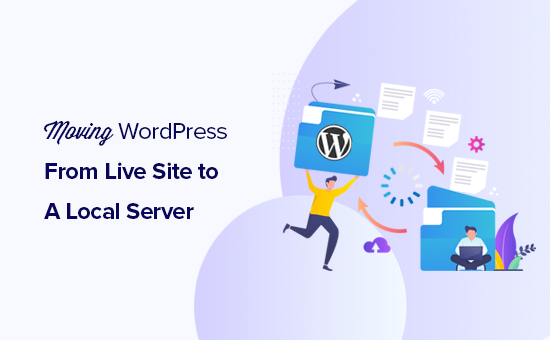
Por que e quem gostaria de mover um site WordPress ativo para um servidor local?
Se você já tem um site WordPress há algum tempo, talvez queira experimentar novos temas ou um plug-in. No entanto, fazer isso em um site ativo pode resultar em uma experiência de usuário ruim para seus usuários.
Para evitar isso, muitos usuários criam uma cópia do site WordPress em um servidor local para testar novos temas, plugins ou fazer testes de desenvolvimento.
Isso permite que você configure o tema com todo o seu conteúdo e teste todos os recursos sem se preocupar com a quebra do site. Muitos usuários copiam seu site para um servidor local para praticar suas habilidades de WordPress e de codificação com dados reais do site.
Embora você possa fazer todos os testes com conteúdo fictício no WordPress, os dados reais do site oferecem uma representação visual melhor de como essas alterações aparecerão no site ativo.
Preparação para mover um site local para um servidor local
Primeiro, você precisa garantir que sempre faça backup do seu site WordPress. Há vários plug-ins excelentes de backup do WordPress que você pode usar.
Em segundo lugar, você precisa instalar um ambiente de servidor local em seu computador. Você pode usar o WAMP para Windows e o MAMP para Mac. Depois de configurar o ambiente, você precisa criar um novo banco de dados usando o phpMyAdmin.
Basta acessar o seguinte URL em seu navegador para iniciar o phpMyAdmin.
http://localhost/phpmyadmin/
http://localhost:8080/phpmyadmin/
A partir daí, você precisa clicar na guia “Databases” (Bancos de dados) e criar um novo banco de dados. Você precisará desse banco de dados para depois descompactar os dados do site ativo.

Agora você está pronto para mover seu site WordPress ativo para o servidor local.
Método 1. Como mover um site WordPress ativo para um servidor local usando um plug-in
Esse método é mais fácil e recomendado para todos os usuários.
A primeira coisa que você precisa fazer é instalar e ativar o plug-in Duplicator. Para obter mais detalhes, consulte nosso guia passo a passo sobre como instalar um plug-in do WordPress.
O Duplicator permite que você crie facilmente um pacote duplicado de todo o seu site. Ele pode ser usado para mover seu site WordPress para um novo local e também pode ser usado como um plug-in de backup.
Observação: Há uma versão gratuita do Duplicator com a qual você pode começar. No entanto, o Duplicator Pro vem com backups ilimitados e recursos mais avançados.
Após a ativação, vá para Duplicator Pro ” Backups na barra lateral do administrador do WordPress. Para criar um novo pacote, você precisa clicar no botão “Add New” (Adicionar novo).
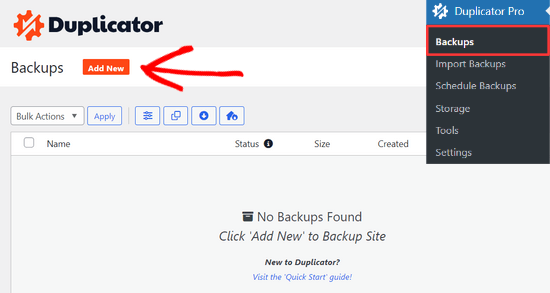
Em seguida, o Duplicator iniciará o assistente de backup.
Primeiro, você precisa inserir um nome para o seu pacote de backup. Você também pode usar as tags dinâmicas para criar automaticamente um formato de nome, como a data e o título do site.

Em seguida, expanda a seção “Storage” (Armazenamento) e escolha um local de armazenamento.
Para este tutorial, usaremos o local padrão. Você pode clicar no link “Add Storage” para adicionar um novo local, como o Dropbox ou o Google Drive, se desejar.
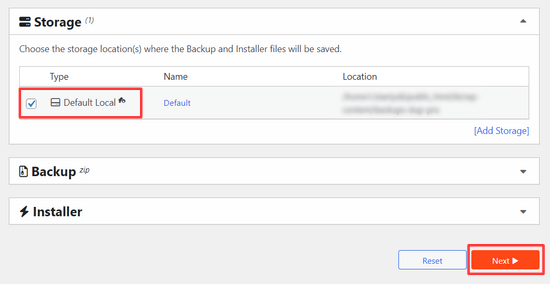
Clique no botão “Next” para continuar.
O plug-in fará uma varredura em seu site e executará algumas verificações em segundo plano. Em seguida, ele mostrará um resumo dessas verificações.
Se tudo estiver correto, clique no botão“Create Backup” para continuar.
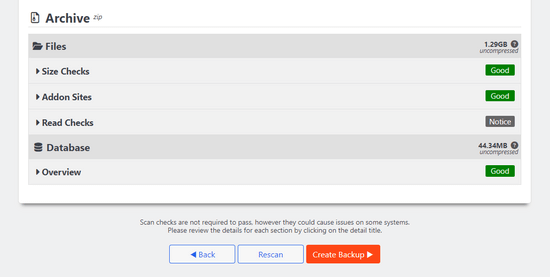
O Duplicator agora criará seu pacote de site.
Quando terminar, você verá um arquivo zip que contém todos os dados do seu site e um arquivo de instalação. Você precisa fazer o download de ambos os arquivos para o seu computador.
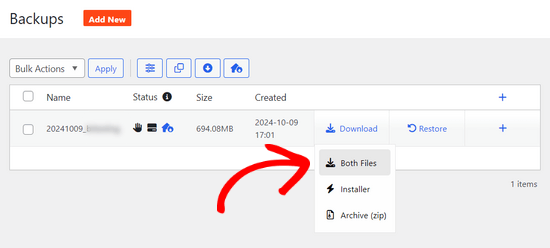
Agora você está pronto para descompactar e instalar esses arquivos em seu servidor local.
Primeiro, você precisa criar uma nova pasta na pasta raiz do seu servidor local. Essa é a pasta em que seu servidor local armazena todos os sites.
Por exemplo, se você estiver usando o MAMP, será a pasta /Applications/MAMP/htdocs/. Como alternativa, se você estiver usando o WAMP, será a pasta C:\wamp\www\.
Dentro dessa pasta, você pode criar novas pastas para cada novo site que deseja importar ou criar em seu servidor local.
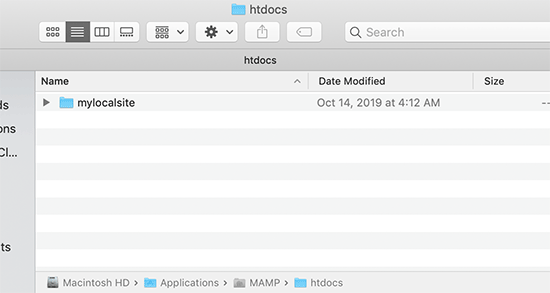
Depois disso, você precisa abrir a pasta criada para o site local e copiar e colar o arquivo zip e o script do instalador que você baixou anteriormente.
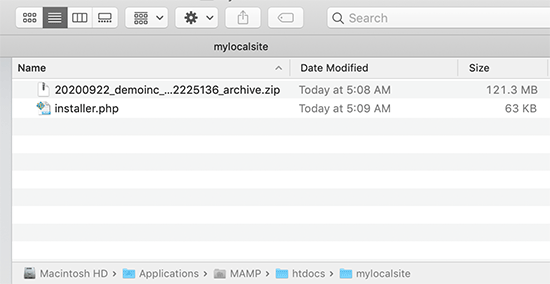
Para executar a instalação, é necessário abrir o script installer.php em seu navegador da Web.
Por exemplo, se você colou os dois arquivos na pasta /mylocalsite/, poderá acessá-los no navegador visitando http://localhost/mylocalsite/installer.php.
Agora você verá o script de instalação do Duplicator como este:
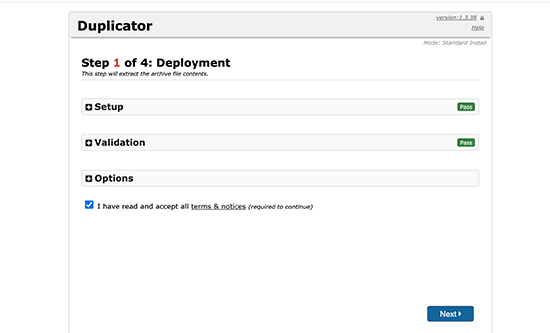
Clique no botão “Next” para continuar.
Agora, o Duplicator descompactará o arquivo zip e solicitará que você insira as informações do banco de dados do site local. Esse é o banco de dados que você criou anteriormente.
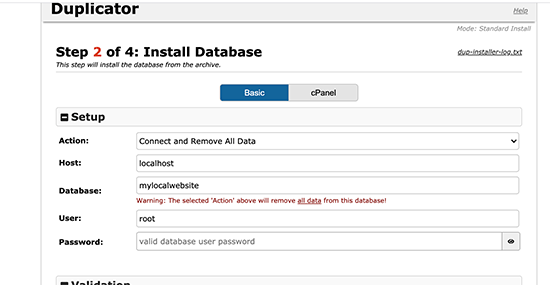
O nome do servidor é quase sempre localhost e o nome de usuário é root. Na maioria dos casos, a instalação do servidor local não tem uma senha definida para root, portanto, você pode deixá-la em branco.
Na parte inferior da página, você verá um botão “Test Database” (Testar banco de dados) que pode ser usado para garantir que as informações do banco de dados estejam corretas.
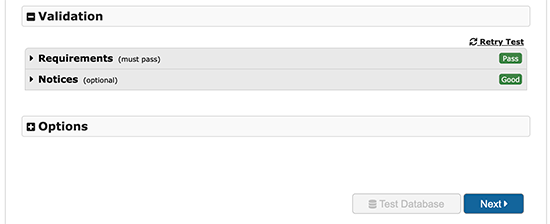
Se tudo estiver correto, clique no botão “Next” (Avançar) para continuar.
O Duplicator agora importará seu banco de dados do WordPress. Depois disso, ele solicitará que você verifique novamente as informações do novo site que ele detectou automaticamente.
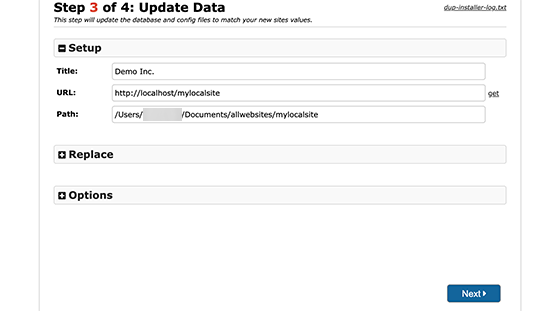
Clique no botão “Next” para continuar.
O Duplicator concluirá a configuração e mostrará um botão para fazer login no seu site local. Você usará o mesmo nome de usuário e senha do WordPress que usa em seu site ativo.
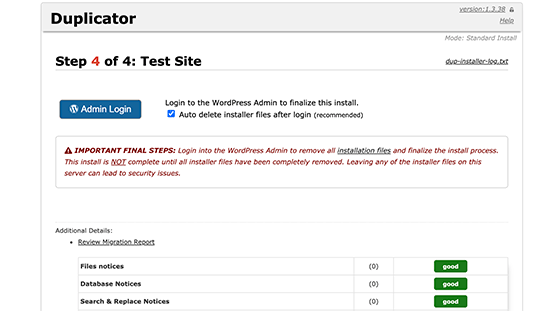
Isso é tudo, você conseguiu mover seu site ativo para o servidor local.
Método 2. Mover manualmente um site WordPress ativo para o servidor local
Caso o plug-in não funcione para você, é possível mover manualmente o site ativo para um servidor local. A primeira coisa que você precisa é fazer o backup manual do seu site a partir da conta de hospedagem do WordPress.
Etapa 1. Exportar o banco de dados do WordPress do seu site ativo
Para exportar o banco de dados do WordPress do seu site ativo, é necessário fazer login no painel do cPanel e clicar em phpMyAdmin.
Observação: Estamos mostrando capturas de tela do painel da Bluehost.
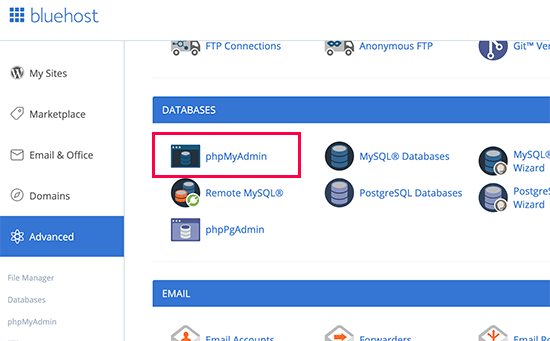
No phpMyAdmin, você precisa selecionar o banco de dados que deseja exportar e, em seguida, clicar na guia Exportar na parte superior.
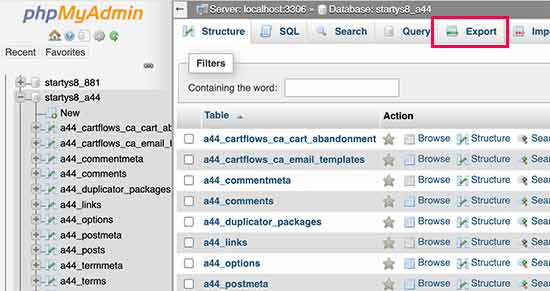
O phpMyAdmin solicitará que você escolha o método de exportação rápido ou personalizado. Recomendamos usar o método personalizado e escolher zip como o método de compactação.
Às vezes, os plug-ins do WordPress podem criar suas próprias tabelas no banco de dados do WordPress. Se você não estiver mais usando esse plug-in, o método personalizado permitirá que você exclua essas tabelas.
Deixe o restante das opções como estão e clique no botão “Go” (Ir) para fazer o download do backup do banco de dados em formato zip.
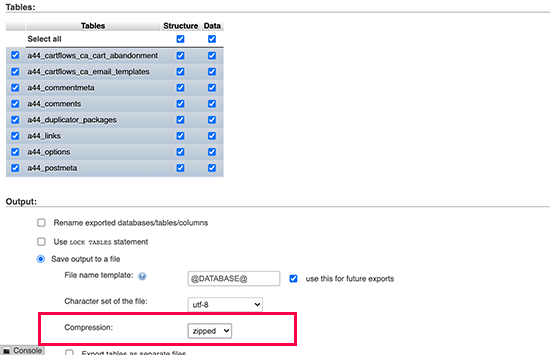
O phpMyAdmin agora fará o download do arquivo do banco de dados. Para obter mais detalhes, consulte nosso tutorial sobre como fazer backup do banco de dados do WordPress manualmente.
Etapa 2. Faça o download de todos os seus arquivos do WordPress
A próxima etapa é fazer o download dos arquivos do WordPress. Para isso, é necessário conectar-se ao site do WordPress usando um cliente FTP.
Depois de conectado, selecione todos os seus arquivos do WordPress e faça o download deles em seu computador.
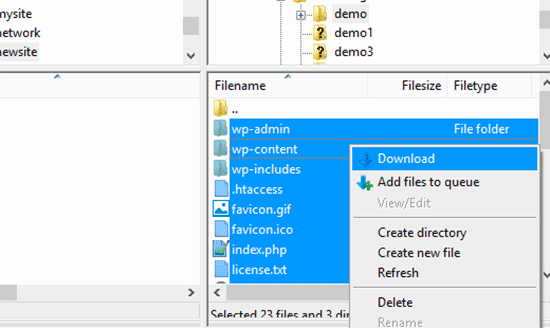
Etapa 3. Importe seus arquivos e banco de dados do WordPress para o servidor local
Depois de fazer o download dos arquivos do WordPress, você precisa criar uma pasta no servidor local para importar o site local.
Se você estiver usando o WAMP, deverá criar uma pasta dentro da pasta C:\wamp\www\ para o seu site local. Os usuários do MAMP precisariam criar uma pasta na pasta /Applications/MAMP/htdocs/.
Depois disso, basta copiar e colar seus arquivos do WordPress na nova pasta.
Em seguida, você precisa importar o banco de dados do WordPress. Basta abrir o phpMyAdmin em seu servidor local visitando o seguinte URL:
http://localhost/phpmyadmin/
Como você já criou o banco de dados anteriormente, agora precisa selecioná-lo e clicar na guia “Import” (Importar) na parte superior.
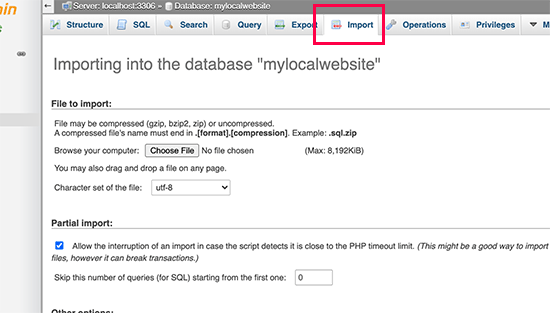
Clique no botão “Choose File” para selecionar e carregar o arquivo de exportação do banco de dados que você baixou na primeira etapa. Depois disso, clique no botão “Go” (Ir) na parte inferior da página.
O phpMyAdmin agora descompactará e importará seu banco de dados do WordPress.
Agora que seu banco de dados está configurado, você precisa atualizar os URLs dentro do banco de dados do WordPress que fazem referência ao seu site ativo.
Você pode fazer isso executando uma consulta SQL no phpMyAdmin. Certifique-se de ter selecionado o banco de dados do site local e, em seguida, clique em SQL.
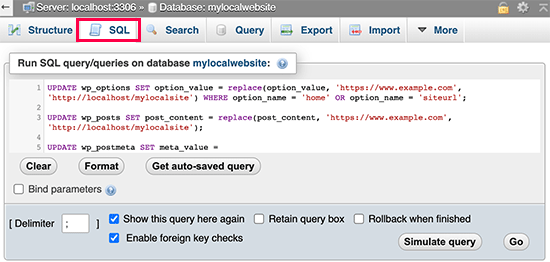
Na tela SQL do phpMyAdmin, copie e cole este código, certificando-se de substituir example.com pelo URL do seu site ativo e http://localhost/mylocalsite pelo URL do servidor local do seu site.
UPDATE wp_options SET option_value = replace(option_value,'https://www.example.com','http://localhost/mylocalsite') WHERE option_name ='home'OR option_name ='siteurl';UPDATE wp_posts SET post_content = replace(post_content,'https://www.example.com','http://localhost/mylocalsite');UPDATE wp_postmeta SET meta_value = replace(meta_value,'https://www.example.com','http://localhost/mylocalsite');
Essa consulta substituirá as referências ao URL do seu site ativo do banco de dados e o substituirá pelo URL do host local.
Etapa 4. Atualizar o arquivo wp-config.php
A etapa final é atualizar o arquivo wp-config.php de seu site local. Esse arquivo contém as configurações do WordPress, inclusive como se conectar ao seu banco de dados do WordPress.
Basta acessar a pasta onde instalou o WordPress em seu servidor local e abrir o arquivo wp-config.php em um editor de texto como o Bloco de Notas.
Substitua o nome do banco de dados pelo nome que você criou no phpMyAdmin em seu host local.
Depois disso, substitua o nome de usuário do banco de dados pelo seu nome de usuário local do MySQL, que geralmente é root. Se você tiver definido uma senha para o usuário root do MySQL em seu host local, digite essa senha. Caso contrário, deixe-o vazio e salve as alterações.
/** The name of the database for WordPress */define('DB_NAME','database_name_here');/** MySQL database username */define('DB_USER','username_here');/** MySQL database password */define('DB_PASSWORD','password_here');
Agora você pode visitar o site local em uma janela do navegador inserindo o URL da seguinte forma:
http://localhost/mylocalsite/
Substitua “mylocalsite” pelo nome da pasta em que você copiou seus arquivos do WordPress.
Isso é tudo, seu site WordPress ao vivo está agora copiado para seu servidor local.
Esperamos que este artigo tenha ajudado você a aprender como mover facilmente um site WordPress ativo para o servidor local. Talvez você também queira consultar nosso guia sobre como criar facilmente um site de preparação para o WordPress para testes ou como mover um site do WordPress do servidor local para o site ativo.
Se você gostou deste artigo, inscreva-se em nosso canal do YouTube para receber tutoriais em vídeo sobre o WordPress. Você também pode nos encontrar no Twitter e no Facebook.





Joseph
Hi, just came across this tutorial today, I found out about some of the steps from other tutorials, but my problem is with the SQL Query. I get the error # MySQL returned an empty result set (i.e. zero rows). I followed all your steps about changing site names etc but cant work this one out and so obviously i cant then connect to the local site. I used the Duplicator before on another site but it wont work so good on this one because of all the images on my photo site, ie timeout issues. Kinda going around in circles here, so help would be good.
Thanks,
Joseph
Yarina
Joseph, check that the table prefix on the SQL tables you are working with are the same. I had this issue before when I didn’t realize that the theme I was copying from had a non typical prefix (wp_extra-text instead of just wp_). When you create the new db on phpMyAdmin, make sure that the prefix matches that of the old db. Hope this helps!
Alan OldStudent
I tried using Duplicator, and that worked with one minor glitch. So then I dropped the database and tried the manual method. All steps proceeded well until it came time to import. I recreated the database and went to import. Afterwards, I got this error message: “#1064 – You have an error in your SQL syntax; check the manual that corresponds to your MySQL server version for the right syntax to use near ‘default’, ‘This is the default profile, used when no profile is specified.’, ‘a:’ at line 7”
To me that looks like gobbledygook. Do you have any idea what went wrong and how I can do the import manually?
Regards,
Alan
WPBeginner Support
This could be a syntax error or conflict caused by using different versions of MySQL. To solve this, when exporting your database choose the same MySQL version as your local install. Also make sure that you are using the same character set for both database tables.
Admin
Em Cloney
Just a quick thing I noticed: the Duplicator file is called “installer.php” rather than “install.php”.
Ben
I noticed the same thing. Great article, though. So glad I heard about this plugin from you guys.
wpva
Hi I decided to do it manually
I created a database for my WordPress site on my local server and tried to import the database that I downloaded before to my computer but im getting this error message:
SQL query:
—
— Database: `aguilar_jmln1`
—
— ——————————————————–
—
— Table structure for table `gm_AnythingPopup`
—
CREATE TABLE IF NOT EXISTS `gm_AnythingPopup` (
`pop_id` int(11) NOT NULL,
`pop_width` int(11) NOT NULL DEFAULT ‘380’,
`pop_height` int(11) NOT NULL DEFAULT ‘260’,
`pop_headercolor` varchar(10) NOT NULL DEFAULT ‘#4D4D4D’,
`pop_bordercolor` varchar(10) NOT NULL DEFAULT ‘#4D4D4D’,
`pop_header_fontcolor` varchar(10) NOT NULL DEFAULT ‘#FFFFFF’,
`pop_title` varchar(1024) NOT NULL DEFAULT ‘Anything Popup’,
`pop_content` text CHARACTER SET utf8 COLLATE utf8_bin NOT NULL,
`pop_caption` varchar(2024) NOT NULL DEFAULT ‘Click to open popup’
) ENGINE=MyISAM AUTO_INCREMENT=2 DEFAULT CHARSET=utf8;
MySQL said:
#1046 – Aucune base n’a été sélectionnée
Kin
It is saying that no database was selected.
Yeah I got that as well.
You need to make sure that you clicked on a database before hitting the ‘import”, if not the admin tool will try to import the .sql file on nothing!!
TMo
Wonderful tutorial on how to manually go through this process. Thank you for the clear directions and photos!
Shane Levine
Hi, is Duplicator an acceptable method for keeping a backup website? I have been using BackWPup but it looks like Duplicator also allows you to create a backup…
Dennis Crayon
Hi I am not sure if I just got lucky but I was able to download and setup the local version quickly. The only problem I am having is that I have to set permalinks to default which is fine locally will I be able to set them back to post name later when I push the whole thing live? Thanks just getting this far is great
WPBeginner Staff
Yes, you can change permalinks after putting your site live.
Felix
Dennis, I am new to wordpress but I have so far learnt key configuration issues. Could you lease hel on changing permalinks from default to post name?
Iftikhar Raja
Just an observation to share.
If you choose custom structure as permalink, it might not work. The work around is to chose default permalink and save the changes. It worked for me after several hours of head scratching
Hope it helps
Mario
If you’re using WAMP you need to turn on mod_rewrite to enable custom permalinks.
Click Wamp -> Apache -> Apache Modules -> rewrite_module
WPBeginner Staff
It is usually enabled by default.
isboleas
Perfect! I did it manually just in wp-config.php must change and the line
/** MySQL hostname */
define(‘DB_HOST’, ‘127.0.0.1 ‘);
With ip appear in phpmyadmin in left up corner.
Anindyo Yudhistiro
I’ve followed all the steps, but I still can’t see my database in my local wp. I still only have Hello World post.
I’ve imported it, change all the url’s, and many row has already affected.
Keith Davis
I used the manual method but the SQL query wouldn’t work for me.
I had to go into the wp-options and change url in siteurl and home table and then all was fine.
Keith Davis
Hi guys
The Duplicator method looks good.
Do you know how much free disc space you need to create the packages?
Nana
Any ideas why it gives me a “Welcome to the famous five-minute install” screen?
WPBeginner Staff
It is possible that your WordPress URL and Site URL are set to localhost/xammp. If you can access the admin area go to settings and set it to your WordPress install directory.
Je
I checked and it’s definitely not set to that. It is so strange!
Je
I figured it out. It was the W3 cache in the htaccess file causing problems. Thanks for you help and for this awesome tutorial!
Jen
Great tutorial, I did everything exactly like you said….I thought it was working until I tried to change the theme and it wouldn’t change. Then I started trying to navigate to other pages and it took me to localhost/xammp. Everytime. Any ideas?
dion
Hi. I did all of this(using the manual option, but when I click on any option, ie login or one of the menu options, I get “the requested URL … was not found on this server”
wagster
If you copy the SQL query straight off the screen above, you will get the line numbers as well, which will throw an error like the above. Click ‘View source’ and copy the clean code from there.
MrDev
Thanks for this article. I tried the manual route of moving a WordPress site to localhost, however my stylesheets are not loading. For some reason the ‘href’ is not being set on all my stylesheets. Any idea what might be going on?
WPBeginner Staff
We would feel more confident recommending BackupBuddy for backups.
NikkiC4lyf
Would you recommend using the Duplicator plugin for doing backups as well as moving sites?
Kin Tatsu
Great tutorial! The problem I’m having is when I login to to wp-admin with the same login and password I used for my live site I get “ERROR: Invalid username. Lost your password?” The username and password are correct for the live site but incorrect for the localhost site. I tried to retrieve password with my email address but it says that my email address is not registered. Any ideas?
pbr
I have only one word about this steps…AAWWEESSOOMMEE!!!!
StefsterNYC
Did you check your Prefixes?
pels
got same error
StefsterNYC
You may have missed a table or something. Do a search for the old prefix. Also make sure you’re using a fresh new WP-CONFIG. I find that sometimes that messes things up.
StefsterNYC
Sorry for the delay Mark. Not sure I understand your question. Hopefully I can answer something here.
If you started with a config file and it originally started with the wp_ and you didn’t use a custom one you’ll be fine. Just remember the config has to match the DB. If you worked locally and are migrating everything to a live site and you use the same DB and same Config that you worked locally with everything should be fine. Just remember to change Username, Password and Hostname.
The key here to remember here is Prefixes. So many people teach you how to do this and that but they miss the one thing that can mess it all up for you. And that is the Prefix.
And User Roles, if missed can cause a major headache when adding Admins manually. So be careful when changing and working with prefixes. They are absolutely a great way to tighten up WP sites. I highly recommend using a custom prefix always. dbh_234_ something like that is a great way to protect your site(s).
WPBeginner Staff
If your live site’s mysql host is not localhost, then you need to change it to localhost. You may also need to change the database name to the database on your local computer. Same goes for DB username which is usually root on local servers, and db password which is usually blank.
Mark
Hi just to be clear the password in the config.php file should be the same as the one you use for myphpadmin? because that seems to work for me?
StefsterNYC
Great tutorial. I believe one thing was missed. Prefix. For those of you that use a prefix in the config, make sure when you query the db you change the wp for the query to your prefix. Otherwise your query won’t reset the urls correctly.
Mark
If I have a local install and I move the database live, the prefix will remain the same correct? Do I need to do anything?
Cypherinfo
Error 404: Object not found: The requested URL was not found on this server. The link on the referring page seems to be wrong or outdated. Please inform the author of that page about the error.
If you think this is a server error, please contact the webmaster.
” I followed all of the steps you wrote.
Sophie
These instructions are exactly what I needed. Thank you!!!
However, I seem to have encountered a problem…
When updating the URLs in my database for those of the local server, it returns a #1064 – error in your SQL syntax near line 3. Could you possibly suggest a solution?
Would I need to include the port number when updating the http://localhost/ part of the code?
Please Help!!
Vtin
One more newbie trouble here! Sorry for the inconvenience.
Of course, I think I’ve done everything correctly (probably not). When I try to access the site via localhost, in the screen appears the index.php file line by line, instead of loading it.
Any ideas?
W
This was fantastic. Super quick and worked exactly as intended.
Paul Sahota
Can you please show how to move a live wordpress site to local using backup buddy on mac using MAMP. I have tried multiple times but it does not work for me. I can easily do the opposite.
thanks
Jeremy
After transferring the live site to my local server (wamp), I navigate to the destination in browser and get a “Not Found” wordpress error. The site’s navigation loads though and when clicked it takes me to the live site. Am I missing something rudimentary?
Kin
I am getting the same thing. I followed all the steps. Then came back to check again, but the error remains. I am seeing that a couple of people above had the same problem as well. Any idea guys of why this is happening?
Sinuhe
Thank you!!! I just finished moving my site and a subdomain to a new hosting service and it worked like a charm. I am no techie, actually I am philosopher I really appreciate you taking the time to explain this info in detail.
I really appreciate you taking the time to explain this info in detail.
Sam
Hey, I did everything the same way you said in manual method.
after setup,
I can see homepage of my website on local server.
But when I try to navigate to other page, I get following error:
“Not Found: the requested URL /test/logistics was not found on this server.”
Please help
Bill
I just ran into the same issue. I went into site/wp-admin. Then went to Setting > Permalinks and just clicked Save Changes. It updated something and all of my links work.
Look at that! My first contribution to the community.
Isabela Santos
thank you! But I had to disable it for it to work…
Mark
Brilliant!
John
Awesome. Worked great! Thanks for posting this.
Natalia
Hi,
I followed your tutorial on doing it manually to the T, but I still get an error message. I am pulling my hair, here…
I’m pretty new to WP and I still have to figure out how to actually enter the new content and modify the files… but I can’t even get it to work locally
This is the message I get:
“Error establishing a database connection”
Which I don’t understand, because I did everything as you said in your tutorial.
Help, please!!
Natalia
Tried it all over again a second time and still same error message… I’m going crazy
Natalia
I even tried in a remote server and I got the same error message. I don’t know what I’m doing wrong… there must be a path somewhere that I’m forgetting about and it’s just not reading the right db…
Someone, please, help!!
WPBeginner Support
Natalia, the most common cause for this error is incorrect database information. On your live site, you need to edit your wp-config.php file. Make sure that the database information in this file matches the database you have created for your live site.
Admin
Kathi Kostiuk
Thank you, your site is super helpful. New to WP, inherited a site, got it localhost so I can learn/test. When trying to ‘upload’ a pic, get this: C:/wamp/www/testsite/wp-content/uploads. Is its parent directory writable by the server? No errors shown in phpMyAdmin, permissions on folders, users look right. Could you possibly direct me to a solution? Have looked everywhere I can think of. Thanks.
WPBeginner Support
When you moved the site to localhost, did you change the siteurl and homeurl options? If you didn’t then you need to add these two lines to your
wp-config.phpfiledefine('WP_HOME','http://localhost/yoursite');define('WP_SITEURL','http://localhost/yoursite');1-click Use in WordPress
Admin
Kathi Kostiuk
Thank you, will do that.
Julie Rondeau
Hi,
Great tutorials! Thank you, however i keep getting an “Unknown” Error code 0 from the Duplicator Plugin when trying to create the packages. Is there any other way you could recommend? Any help would be really appreciated.
Thank you so much,
Best from Paris.
J.
WPBeginner Support
You can also manually backup your localhost site and restore it on live server.
Admin
Rehan
Best tutorial ever!!
Ashley
Hi! Thank you so much for your great tutorials! Everything worked out great, but I when I was supposed to “resave permalinks” it wouldn’t let me login. I got that fixed and I am logged in now, but where do I go to resave them now that I don’t have that pop up? I’m assuming this is why when I try to click on posts it gives me a “not found page” ? Thanks in advance!
WPBeginner Support
You can save permalinks from Settings » Permalinks.
Admin
Jesse
Can I ask how you fixed the login problem? I’m getting the same issue.
Yarina
Hi! This all worked great until I had to login to the wp dashboard, my login didn’t work and even after changing it manually in the users table, I couldn’t log in, any ideas…?
Angela
Thank You! I’ve been trying to do this for some time now. I’ve watch several YouTube videos but could not get it to work correctly. This was so easy….the best thing ever. Again thanks!
Ivan
Hi,
I followed your instructions to the letter (and sing lol), but was not successful. I think it has something to do with WP installation. I have not installed it, just copied it.
Brett Golding
Didn’t work for me just ended up with a blank white home page after I ran the program. Re tried 3 times.
WPBeginner Support
Checkout how to resolve white screen of death issue.
Admin
Jason Moore
Thank you! This is was too easy!
ron
Hi, I’m trying to do exactly this, but I get a 500 Internal Server Error right after I put the database details and hit the Run Deployment button, I get the progress animation and after about 10 or 15 seconds I get the error.
I was looking at the error logs located at C:\wamp\logs and I could only find this line that seemed somewhat relevant: “Invalid command ‘RewriteOptions’, perhaps misspelled or defined by a module not included in the server configuration”.
I’ve successfully used duplicator in the past, but going from webserver to another webserver.
Any ideas?
WPBeginner Support
Please take a look at our guide on how to fix 500 internal server error in WordPress.
Admin
Usama Noman
Thanks, seems like this is a tutorial posted upon my request Thanks guys you are doing good.
Thanks guys you are doing good.
WPBeginner Support
Yes it is Usama. Thank you for suggesting it to us.
Admin
Jamie Mannion
Good guide, but I think you missed the part where you update wp-config.php with the new database details – name is the new name, username is ‘root’ and password is empty.
I tried it manually and it all looks good but the links take me to the WAMP server configuration page, even though the URLs are updated – can’t figure it out. I can get the home page and admin, but that’s it. Cheers!
WPBeginner Support
Thanks for pointing out updating wp-config.php thing. We have updated the article.
As for your redirection issue. Try deleting .htaccess file from wordpress installation on your localserver.
Admin
Jamie Mannion
Awesome, thanks! I removed the .htaccess, then visited the permalinks option page and saved and now we’re good! I should admit, the only reason I knew about the wp-config.php settings is because I’ve read your previous articles. Keep up the great work!
Kin
I put a question earlier today, but this worked out for me great.
Thank you.
Shahraar Khan
I do this manually. Just zip the files from the server and download it… export the database and replace all the links in my text editor. just a 5 min work.. But anyhow your tutorial is also a very good alternative.